“In an honest service there is thin commons, low wages, and hard labour. In this, plenty and satiety, pleasure and ease, liberty and power; and who would not balance creditor on this side, when all the hazard that is run for it, at worst is only a sour look or two at choking? No, a merry life and a short one shall be my motto.”
A General History of the Pyrates (1724)
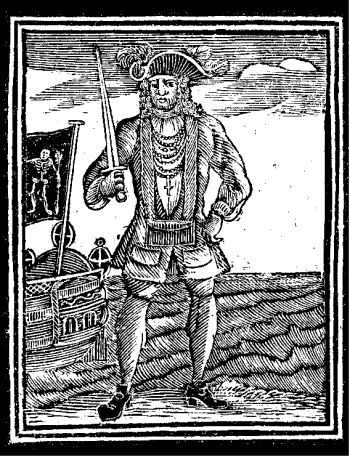 Active between 1719 and 1722, Bartholomew Roberts is viewed as being one of the most successful pirates, when judged by the amount of vessels captured. It is thought he took as many as 470 vessels, albeit the half of them being fishing boats. Born with the Christian name John, it is unsure why he took the name Bartholomew. Some say he adopted the name in reference to the legendary buccaneer Bartholomew Sharp, others say in order to hide his true identity. The widespread nickname ‘Black Bart’ was first mentioned in a poem long after his death. Not much is known about his background, other than that he was a Welshman born on 17th May 1682. He grew up in Pembrokeshire in a strict Calvinist family. Little more is known about his early life, but he probably went to sea at an early age and might have served in the Royal Navy. He was 3rd mate on a slave ship called the Princess when it was taken by Howell Davis on the Royal Rover off the Gold Coast in 1719. At first, he was reluctant to join the pirates, but after Howell Davies was killed in an ambush on the island of Principe, Roberts embraced the way of life after he was unanimously elected to take over as captain, probably chosen because of his charisma and navigating skills. He is said to have been generally distant from his crew and often behaved more like a naval captain, indicating he might have been in the Royal Navy at some time or other. His dress was flamboyant, he wore a feather hat, jewellery, and a crimson damask waistcoat with a silk pistol sling. Such was Roberts’ love of scarlet wardrobe accessories, it is said the French nicknamed him le Jolie Rouge. It has sometimes been claimed he was teetotal, but there is no evidence of this.
Active between 1719 and 1722, Bartholomew Roberts is viewed as being one of the most successful pirates, when judged by the amount of vessels captured. It is thought he took as many as 470 vessels, albeit the half of them being fishing boats. Born with the Christian name John, it is unsure why he took the name Bartholomew. Some say he adopted the name in reference to the legendary buccaneer Bartholomew Sharp, others say in order to hide his true identity. The widespread nickname ‘Black Bart’ was first mentioned in a poem long after his death. Not much is known about his background, other than that he was a Welshman born on 17th May 1682. He grew up in Pembrokeshire in a strict Calvinist family. Little more is known about his early life, but he probably went to sea at an early age and might have served in the Royal Navy. He was 3rd mate on a slave ship called the Princess when it was taken by Howell Davis on the Royal Rover off the Gold Coast in 1719. At first, he was reluctant to join the pirates, but after Howell Davies was killed in an ambush on the island of Principe, Roberts embraced the way of life after he was unanimously elected to take over as captain, probably chosen because of his charisma and navigating skills. He is said to have been generally distant from his crew and often behaved more like a naval captain, indicating he might have been in the Royal Navy at some time or other. His dress was flamboyant, he wore a feather hat, jewellery, and a crimson damask waistcoat with a silk pistol sling. Such was Roberts’ love of scarlet wardrobe accessories, it is said the French nicknamed him le Jolie Rouge. It has sometimes been claimed he was teetotal, but there is no evidence of this.
Roberts’ pirating career begins
After taking command of the Royal Rover, his first act was to avenge Howell’s death by attacking the Portuguese fort and burning a few ships where Howell had died. After that he took several ships, including a Dutch Guineaman and an English ship called Experiment, off the coast of Africa, after which his crew voted to return to the West Indies. First they arrived in Brazil, using the island of Ferdinando as a base. As they were about to leave for the West Indies, they stumbled upon a Portuguese fleet of 42 merchant ships anchored in Todos os Santos Bay along with two men-of-war nearby, which were there to escort the fleet to Lisbon. In a daring action, Roberts sailed approached one vessel slightly apart from the resr of the Portuguese fleet with most of his crew hidden below deck. A single ship appeared harmless to the Portuguese, who believed it to be a French merchant vessel. Roberts and his men managed to overcome the crew of the vessel by surprise and find out which was the richest ship in the fleet. He was informed by the captain of the captured ship that it was the Sagrada Familia, with 40 guns and a crew of 150 men. Although it was extremely risky, Robert’s men managed to board the vessel with only two casualties. The fleet and escort ships were now alerted so Roberts fled with his prize, amazingly managing to escape unscathed. The booty from the raid is said to have consisted of 40,000 gold coins, sugar, tobacco, hides, and some jewellery, including a cross pendant set with diamonds destined for the King of Portugal, John V.
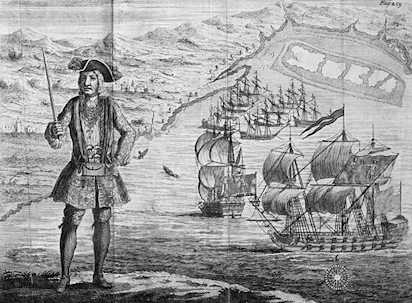 Roberts and his crew later sailed to Guiana and Suriname. At the Suriname River they captured a sloop from Rhode Island, but while attempting to also take its brigantine consort in the captured sloop, leaving behind his other two vessels, his Irish quartermaster Walter Kennedy absconded with the Royal Rover and most of the plunder. When Roberts returned only a few loyal men remained. Due to this betrayal, Roberts developed a hatred of all Irishmen, forbidding any of them from joining his crew. Later he renamed the sloop the Fortune. In February 1720, Roberts sailed to the Caribbean together with the French pirate Montigny la Palisse, who commanded the Sea King, where they captured three ships. Then Roberts sailed to Barbados, where he tried to capture two ships, Summerset and Philipa, which turned out to be pirate-hunters. He only managed to escape with considerable losses after dumping most of his cargo and guns overboard, while the Sea King abandoned him. After this incident he developed a hatred of Barbadians. He next sailed to Martinique, where he wanted to careen his ship, but was unfortunately discovered, and several armed sloops were sent by the Governor to hunt him down. Again Roberts only narrowly managed to escape. These two experiences led him to create his infamous flag depicting him standing on the head of a Barbadian and a Martiniquian; ABH (A Barbadian’s Head) under one and AMH (A Martinican’s Head) under the other.
Roberts and his crew later sailed to Guiana and Suriname. At the Suriname River they captured a sloop from Rhode Island, but while attempting to also take its brigantine consort in the captured sloop, leaving behind his other two vessels, his Irish quartermaster Walter Kennedy absconded with the Royal Rover and most of the plunder. When Roberts returned only a few loyal men remained. Due to this betrayal, Roberts developed a hatred of all Irishmen, forbidding any of them from joining his crew. Later he renamed the sloop the Fortune. In February 1720, Roberts sailed to the Caribbean together with the French pirate Montigny la Palisse, who commanded the Sea King, where they captured three ships. Then Roberts sailed to Barbados, where he tried to capture two ships, Summerset and Philipa, which turned out to be pirate-hunters. He only managed to escape with considerable losses after dumping most of his cargo and guns overboard, while the Sea King abandoned him. After this incident he developed a hatred of Barbadians. He next sailed to Martinique, where he wanted to careen his ship, but was unfortunately discovered, and several armed sloops were sent by the Governor to hunt him down. Again Roberts only narrowly managed to escape. These two experiences led him to create his infamous flag depicting him standing on the head of a Barbadian and a Martiniquian; ABH (A Barbadian’s Head) under one and AMH (A Martinican’s Head) under the other.
Roberts sails north
Due to the presence of too many pirate hunters in the Caribbean, Roberts and his men decided to sail to Newfoundland in the summer, where they raided several harbours, the largest being Trepassey, a trading and fish salting centre. In June of 1720, he captured twenty-two merchant and 150 fishing boats there, most of which were abandoned without resistance. A brig from Bristol was taken over by the pirates to replace the sloop Fortune and was fitted out with 16 guns. In A General History of the Pyrates it is claimed Roberts destroyed the fisheries and burnt all the ships, but one fisherman who witnessed the attack said Roberts burnt only one ship and paid for supplies instead of stealing them. He did take one ship, the Bristol Galley, as his flagship, renaming her the Royal Fortune, the first in a series of ships which carried this name. During July 1720, Roberts captured nine or ten French ships, commandeering one of them, fitting her with twenty-six cannons and changing her name to Good Fortune.
Back in the Caribbean
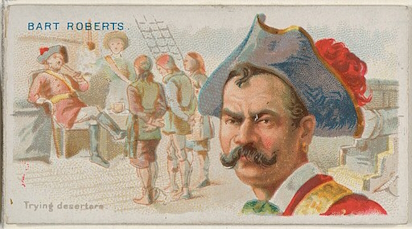 Roberts returned to the Caribbean and in September 1720 careened and repaired the Good Fortune on the island of Carriacou in the Grenadine Islands, renaming it Royal Fortune. He then wanted to sail to Basseterre on the island of St. Christopher (Saint Kitts) to sell stolen goods, but heard of the fate of his old ship and crew that had left with Walter Kennedy. Kennedy had escaped but most of crew were hanged and the Royal Rover was burnt. Roberts set sail for the island bent on revenge. In late September, the Royal Fortune arrived at St. Christopher and entered the Basseterre Road. They sailed in among the ships in the Road, all of which promptly struck their flags. The pirates were prevented from attacking the town itself by adverse winds. They were then driven off by the guns in the fort, burning a couple of ships as they left. Roberts set fire to several ships in harbour in the Leeward Islands as revenge for the recent hanging of brethren pirates on St. Christopher and the failed attack on the town. The next landfall was at the island of St. Bartholomew, where the French governor allowed the pirates to remain for several weeks. By 25th October, they were at sea again off St. Lucia, where they captured up to fifteen French and English ships. Later, they captured another ship which Roberts also renamed the Royal Fortune. Capturing many vessels, Roberts become widely known and feared throughout the Caribbean and Americas. In A General History of the Pyrates, Charles Johnson claims that he captured the Governor of Martinique and took his revenge by hanging him from the yardarm. According to several historians, this reported capture might have been an embellishment, although French sources confirm that Roberts did capture and torture some French officials by pretending to hang them.
Roberts returned to the Caribbean and in September 1720 careened and repaired the Good Fortune on the island of Carriacou in the Grenadine Islands, renaming it Royal Fortune. He then wanted to sail to Basseterre on the island of St. Christopher (Saint Kitts) to sell stolen goods, but heard of the fate of his old ship and crew that had left with Walter Kennedy. Kennedy had escaped but most of crew were hanged and the Royal Rover was burnt. Roberts set sail for the island bent on revenge. In late September, the Royal Fortune arrived at St. Christopher and entered the Basseterre Road. They sailed in among the ships in the Road, all of which promptly struck their flags. The pirates were prevented from attacking the town itself by adverse winds. They were then driven off by the guns in the fort, burning a couple of ships as they left. Roberts set fire to several ships in harbour in the Leeward Islands as revenge for the recent hanging of brethren pirates on St. Christopher and the failed attack on the town. The next landfall was at the island of St. Bartholomew, where the French governor allowed the pirates to remain for several weeks. By 25th October, they were at sea again off St. Lucia, where they captured up to fifteen French and English ships. Later, they captured another ship which Roberts also renamed the Royal Fortune. Capturing many vessels, Roberts become widely known and feared throughout the Caribbean and Americas. In A General History of the Pyrates, Charles Johnson claims that he captured the Governor of Martinique and took his revenge by hanging him from the yardarm. According to several historians, this reported capture might have been an embellishment, although French sources confirm that Roberts did capture and torture some French officials by pretending to hang them.
Roberts in Africa
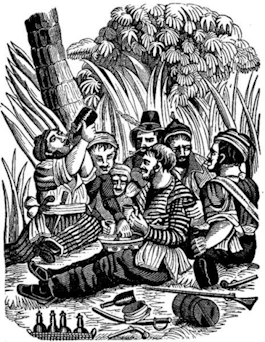 In the spring of 1721, Roberts headed back to Africa via the Cape Verde islands. During the voyage he had a dispute with a crewmember, whom he stabbed, but in return he was then badly beaten by his injured opponent, which indicated that he wasn’t all-powerful on board the ship. On 18th April, Thomas Anstis, the commander of Good Fortune, left Roberts sneakily in the night and continued to raid shipping in the Caribbean. On 12th June 1721 Robert captured several French ships on the Senegal River, taking one as a consort naming it the Ranger. In August 1721, he captured two slaving ships at Point Cestos, including the frigate Onslow, which he took as his own renaming it Royal Fortune yet again. He spent November and December of that year careening and resting at Cape Lopez and the island of Annobón. At some point he learnt, allegedly from an ex-pirate, that two Royal Navy ships, HMS Swallow and HMS Weymouth were hunting him. Bartholomew Roberts is said to have carried out some misdeeds while in Africa, such as burning the village of Calabar after the crew was refused access to women by hostile natives. In January 1722, in Whydah Roberts captured eleven ships, which he said he would return them for a ransom. The captain of the slave ship Porcupine refused to pay, so Roberts had the vessel set alight with the eighty slaves still aboard.
In the spring of 1721, Roberts headed back to Africa via the Cape Verde islands. During the voyage he had a dispute with a crewmember, whom he stabbed, but in return he was then badly beaten by his injured opponent, which indicated that he wasn’t all-powerful on board the ship. On 18th April, Thomas Anstis, the commander of Good Fortune, left Roberts sneakily in the night and continued to raid shipping in the Caribbean. On 12th June 1721 Robert captured several French ships on the Senegal River, taking one as a consort naming it the Ranger. In August 1721, he captured two slaving ships at Point Cestos, including the frigate Onslow, which he took as his own renaming it Royal Fortune yet again. He spent November and December of that year careening and resting at Cape Lopez and the island of Annobón. At some point he learnt, allegedly from an ex-pirate, that two Royal Navy ships, HMS Swallow and HMS Weymouth were hunting him. Bartholomew Roberts is said to have carried out some misdeeds while in Africa, such as burning the village of Calabar after the crew was refused access to women by hostile natives. In January 1722, in Whydah Roberts captured eleven ships, which he said he would return them for a ransom. The captain of the slave ship Porcupine refused to pay, so Roberts had the vessel set alight with the eighty slaves still aboard.
Roberts’ End
Roberts and his crew considered returning to Brazil, but adverse winds stopped them doing so. They were anchored of Cape Lopez near the Equator when discipline started breaking down and discontentment was increasing. Additionally, there was much excessive drinking. On 5th February 1722 they spotted what they thought was a merchant ship in the distance, but only the Ranger commanded by James Skyrme was in a condition to pursue. The merchant was in fact the British warship HMS Swallow commanded by Captain Challoner Ogle. After two hours of exchanging fire the Ranger surrendered with ten pirates dead and Skyrme having lost his leg. HMS Swallow returned to Cape Lopez to find Royal Fortune still there, the crew celebrating after having just captured a ship called the Neptune. It soon became clear to Roberts that the approaching ship was a naval vessel and not the returning Ranger.
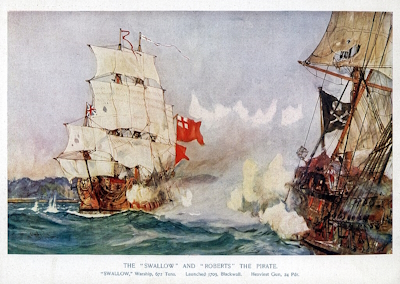 The pirates were not prepared for an encounter with a stronger naval vessel. They tried to escape but a misjudgment by the helmsmen and the dropping off of the wind put them in a difficult position. Roberts was the only one killed in the initial broadside from the Swallow – killed by grapeshot. His body was hastily thrown overboard before it could be seized by the authorities. The pirates then resisted for another two hours, surrendering when their ship became too damaged to fight on. One member of the crew, John Philips, tried to reach the magazine with a lighted match to blow up the ship, but was prevented from doing so by two other crewmembers. Ten pirates had been killed on the Ranger and only three on the Royal Fortune, including Roberts. In total, 267 pirates were said to have been captured on the Royal Fortune and Ranger and taken to Cape Coast Castle in Guinea, where they were put on trial. About twenty men died of their wounds or disease before they could be tried. The 70 Africans taken aboard both ships were enslaved; 52 pirates were hanged in sight of the walls of Cape Coast Castle; 20 men had their sentences commuted to seven years of indentured labour in West African mines; 17 were sent to Marshalsea Prison in London; 76, including the forced musicians, were acquitted or respited. Details about the trial of Roberts’ crew can be found in A General History of the Pyrates. Captain Challoner Ogle was knighted for his success.
The pirates were not prepared for an encounter with a stronger naval vessel. They tried to escape but a misjudgment by the helmsmen and the dropping off of the wind put them in a difficult position. Roberts was the only one killed in the initial broadside from the Swallow – killed by grapeshot. His body was hastily thrown overboard before it could be seized by the authorities. The pirates then resisted for another two hours, surrendering when their ship became too damaged to fight on. One member of the crew, John Philips, tried to reach the magazine with a lighted match to blow up the ship, but was prevented from doing so by two other crewmembers. Ten pirates had been killed on the Ranger and only three on the Royal Fortune, including Roberts. In total, 267 pirates were said to have been captured on the Royal Fortune and Ranger and taken to Cape Coast Castle in Guinea, where they were put on trial. About twenty men died of their wounds or disease before they could be tried. The 70 Africans taken aboard both ships were enslaved; 52 pirates were hanged in sight of the walls of Cape Coast Castle; 20 men had their sentences commuted to seven years of indentured labour in West African mines; 17 were sent to Marshalsea Prison in London; 76, including the forced musicians, were acquitted or respited. Details about the trial of Roberts’ crew can be found in A General History of the Pyrates. Captain Challoner Ogle was knighted for his success.
The Royal Fortune
Four or five of Bartholemew Robert’s ships carried the name Royal Fortune. The first ship might not have had this name and not much know about it. It is thought to have been a two-masted brig fitted with oars, carrying 16 guns. The second vessel was a fully rigged ship of 220 tons with 32 cannons. At first it was called the Good Fortune, but was later renamed Royal Fortune. It was eventually abandoned after becoming too leaky. The third ship was a 22 ton brig with 32 guns, and the fourth, which was probably the most famous, was a Dutch ship with a staggering 51 guns. This ship also became too leaky to sail. The fifth and final vessel was a frigate with three square rigged masts, which had been a slave ship belonging to the Royal Africa Company before it was taken by Roberts. It may have seemed less impressive than its forerunner, but was still a large ship of 410 tons with 12 guns later upgraded to 40. The forecastle was removed and quarterdeck lowered to improve sailing performance. Roberts died on this ship in the fateful confrontation with HMS Swallow, a fifth rate ship packing 50 guns. For more information on these ships check out the informative video on the Gold and Gun Powder YouTube channel titled The Royal Fortune.
Conclusion
Bartholomew Roberts was often arbitrary in his behaviour, and could sometimes be cruel and authoritarian. Black Bart was not as cruel to prisoners as some pirates such as Edward Low and Francis Spriggs, but did not treat them as well as did Samuel Bellamy, Howell Davis, or Edward England. He would sometimes give gifts to cooperative captains and the crews of captured ships, such as pieces of jewellery or items of captured cargo, but he would often forced men to serve under him, many men being acquitted at trial for this reason. It is reported he even killed two men for deserting the ship. He had a strict set of Articles, one of few which have survived, probably written after Walter Kennedy stole away with the Royal Rover to prevent this happening again. He had many blacks in his crew, but was no liberator, as it was said he treated them as second class citizens, and he even left slaves to be burnt alive on a ship he set fire to Whydah harbour. He took around 470 ships over a three year period, which might sound impressive, but one has to bear in mind that more than half were fishing boats. Many say the Golden Age of Piracy came to an end with Robert’s death, as there was no one to match him in the year that followed.
You can read more about Roberts and his crew on the website of Pascal Bonenfant.
Click on the flags attributed to Bartholomew Roberts for more information:
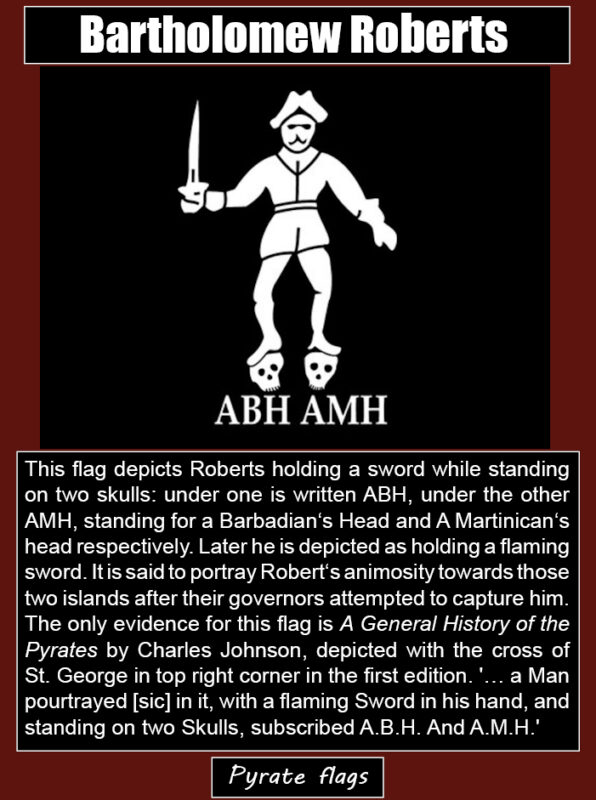 |
 |
 |
 |
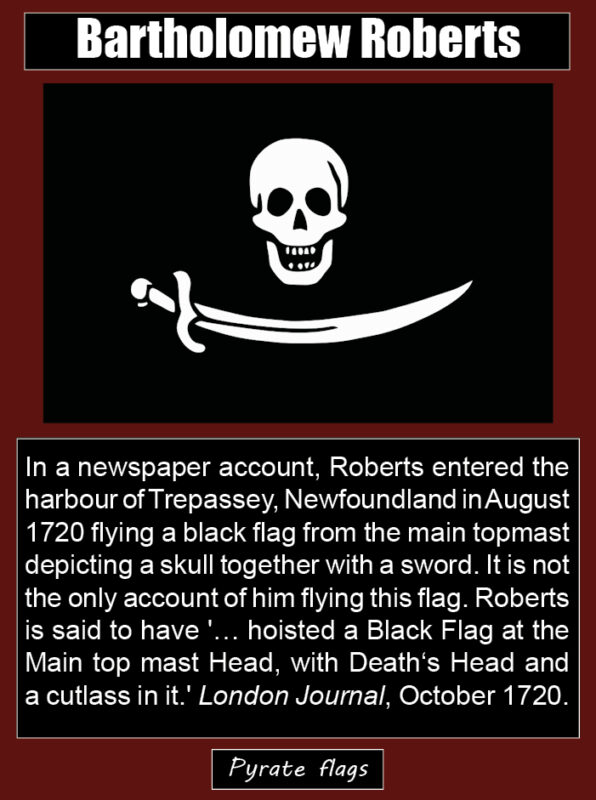 |
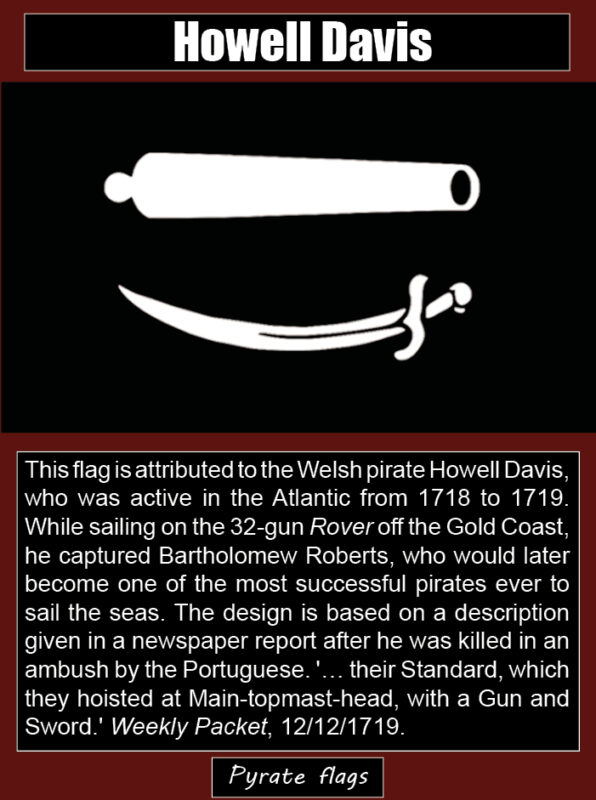 |
